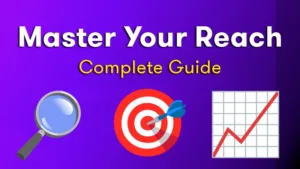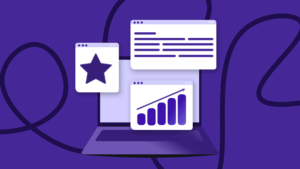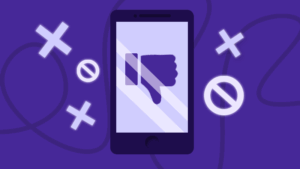How To Master Reach – A Complete Guide On Calculating And Maximizing This Critical Metric
With over 7 years of e-commerce experience, Agne has mastered the balance of creativity and performance. From guiding social media strategies to crafting high-converting ads, she’s all about results.

You want to know your brand is getting a return on advertising spend. If it isn’t, you could be wasting money.
But how can you tell if your activities are profitable?
One method is to calculate “reach.” It measures the impact of your advertising campaigns, measuring their success objectively.
But first, what is marketing reach?
Reach refers to the number of people you engage with in a campaign. For example, suppose you spend $1,000 on an online ad and 10,000 people see it. That would imply a reach of 10K.
Because of this, reach is a metric that gauges the scale of a marketing opportunity you face. The higher it is, the better.
For example, millions of people will see a Super Bowl ad. But your reach will be considerably lower if it’s a banner ad on a website no one visits.
Sometimes, marketers apply percentage corrections to specific advertising categories to estimate reach in advance. For example, researchers know people scroll past ads on their social media feeds without noticing them. But they will almost always hear a radio ad in the car. For this reason, you might have a correction factor of 10% for a radio ad, meaning out of a listenership of 100,000 people, 90,000 hear it. Meanwhile, this adjustment might be 50% for a Facebook ad and 75% for a branded blog.
How Do We Define “Reach?”
Reach comes in various forms:
- Organic
- Paid
- Social Media Reach
Organic reach refers to the people likely to see your content without paid promotion, such as a post that goes viral on Instagram. Most brands aim for this reach type since it is free.
Paid reach, by contrast, is the size of campaign engagement when you spend money on it. For most outreach efforts, this number should be larger than organic content.
Social media reach refers to the total number of users likely to see your content on platforms like Facebook, Instagram, and Twitter. It’s helpful for brands wanting to measure the impact of paid campaigns in specific channels.
Your brand should focus on the reach metrics likely to help it the most. Organic reach can be useful when measuring the success of SEO campaigns, while paid and social media reach provide direct return-on-investment (ROI) information.
Methods to Calculate Reach
Reach calculations depend on the type of reach you want to estimate.
One option is to calculate reach manually. Assuming you have data, you can calculate paid reach as:
- Paid Reach = Unique impressions from paid campaigns
You can also calculate organic reach as:
- Organic Reach = Total unique impressions – Paid unique impressions
If you have no paid impressions (because you aren’t spending money on ads), your organic reach is the same as your total reach.
You can calculate your total reach by summing organic and paid reach (if your tools calculate those separately). For example, suppose your paid reach is 5,000 and your organic reach is 7,000 for a total reach of 12,000. Then, you can use this information to calculate how much you need to spend on ads to reach your impression goals. For example, you could target 20,000 views but only need to achieve a paid reach of 10,000 to hit that number.
Note that impressions aren’t the same as reach. The former refers to the number of times people view your content, while the latter only cares about the number of users who see it (hence the term “unique impressions” in the above equations).
For example, if Jessica and Susie see your content twice each, and John sees it once, that’s five impressions but a reach of three (since only three people saw it).
Using Analytical Tools To Calculate Reach
Usually, it is simpler to use analytical tools to calculate your reach. These do the calculations for you, avoiding manual work.
Google Analytics, for instance, tracks the number of unique visitors reaching your site. You can see things like the total views of a page and the number of distinct views by selecting Overview in the Audience section.
Social platforms also offer insights that track reach, including X, Facebook. And Instagram. You can use these to measure the number of people who see a post (helpful for paid and organic) and the number of times platforms display marketing content.
Calculating Reach Across Platforms
If you use multi-channel marketing, you occasionally need to calculate reach across platforms. This approach allows you to estimate the ROI for each channel.
For email marketing, you can calculate reach as:
- Reach=Total emails sent open rate
For example, if you send 1,000 emails and the open rate is 0.35, the reach is 350.
For websites, you can use Google Analytics to calculate how many individuals reach your site (perhaps following an SEO drive).
You can also calculate reach per page (helpful for landing pages) using the following equation:
- Page Reach =Unique pageviews (Total visitors Total sessions)
Most social media sites measure reach internally (so you don’t need to whip out a calculator or use third-party software). Here’s what to do:
- X: Use X Analytics to measure the number of impressions on specific tweets.
- Instagram: Use internal analytics to see how many people view a post.
- Facebook: Use Facebook Insights to calculate the reach of specific posts (by logging viewer numbers).
Most brands use software tools and manual calculations to determine their reach. It can vary significantly from one platform to another, so always consider your channel budget.
What Factors Affect Your Brand’s Reach?
Increasing your organic reach requires a smarter approach than just spending more money. You also have to consider other factors.
Content Quality and Relevance
Top of your list of priorities should be quality. Creating content that your audience wants to consume is always the best strategy. Your output should be watchable and shareable (not forgettable!)
Relevance matters too because it lets you capture and retain your audience’s attention. People must feel engaged by what you’re doing.
You can improve the quality and relevance of your outreach efforts by:
- Using storytelling and visuals to tell people more about your brand
- Researching audience’s pain points to learn what they dislike and how you can help them overcome the issues they face
- Remaining current with the top industry trends (and following what’s happening in the rest of the community)
For example, you could partner with influencers to create a product demo. Or you could offer a behind-the-scenes look at your business.
Audience Engagement
Audience engagement can also determine reach. The more people feel a sense of community (as part of your brand), the more likely you will reach a broader audience.
To increase your engagement with your audience, you can:
- Respond to comments
- Encourage more user-generated content (UGC)
- Message people in the DMs to make your relationships more personal
- Encourage interactions (i.e. through polls, questions, or surveys)
For example, you could ask your audience which product research priorities they’d prefer. Alternatively, you could create forums or groups where audience members discuss topics relating to your brand or how to use your products.
Platform-Specific Algorithms
Algorithms can also affect your reach. Platforms use sophisticated software to determine when and how they display content to users.
Unfortunately, you don’t have much control over algorithms, but there are still things you can do to improve the likelihood of being seen. For example, using new features the brand wants to promote can help. Many creators saw a boost when they hopped on the YouTube Shorts videos or Instagram Reels bandwagons early.
Timing And Frequency
Timing and frequency also play a role in social media and SEO. If you can reach out to users when they are most active, your posts are more likely to get seen.
To nail your timing, use analytical tools (like TweetHunter) to figure out when you should post. Then, create a schedule once you know the best time. (You can schedule posts with paid tools like Hootsuite).
Usually, brands post several times per day. However, some platforms may only require posts every other day or even once per week.
Best Practices for Maximizing Your Reach And Achieving Your Marketing Goals
Knowing what affects reach is only part of the story. You should also know specific tactics to enhance it (which we briefly discussed above).
Here’s what to do in detail:
Consistent Content Posting
Consistent posting should be at the top of your priority list. It stimulates social media algorithms, encouraging them to promote your content.
Daily posts work because that’s what social media platforms want. Their goal is to get people to log on and view content from their favorite creators every day for maximum ad exposure.
Therefore:
- Make posts relevant to your brand
- Create a mixture of marketing posts and educational content
- Leverage hashtags in posts (if available on your platform)
- Run organic content alongside paid options
- Use polls, surveys, and quizzes where necessary
Leveraging Influencers and Partnerships
Another approach we recommend at Billo is to use influencers and social media content creators. Social media personalities can amplify your audience across platforms, helping you reach more people with relatively low effort.
Furthermore, the quality of the new impressions you generate will likely be higher. Influencers and UGC creators tend to have better engagement rates than conventional brands.
Creators may require payment. But the rewards are often worth the expense. Partnering with the right people can increase click-through rates, conversions, sales, brand awareness, and return on ad spend.
Use Paid Advertising Strategies
Of course, you can also use paid ad strategies to increase reach. These target specific demographics and interests to find social media users who could benefit from what you sell.
The most critical variables to target are age, gender, and location. These help you find people in your niche who match your buyer persona.
Depending on the platform, you can also target the following:
- Language (i.e. English, Spanish, Mandarin, etc.)
- Purchasing behaviors
- Device usages
- Hobbies
- Daily activities
- Income profile or occupation
Facebook is a top option for paid advertising strategies because it lets you target “similar audiences” to other brands. LinkedIn also has numerous customization options based on industry, sector, and company size. These tools simplify the audience selection process, making it simpler to start.
Once your primary advertising is up and running, consider retargeting campaigns. These are useful when users encounter your brand but don’t convert the first time.
The most common method is website retargeting where you show prospects your ads on third-party sites (usually in banner form). Ecommerce brands often use this tactic for leads who abandon their carts before purchasing to encourage them to return to their store.
Email retargeting campaigns are another option. These are often highly effective if you have a list of addresses because people pay more attention to their inboxes than website sidebars. Just make sure to regularly conduct a domain health check to authenticate your emails, ensuring they land in the right inboxes and improving deliverability, ultimately boosting the effectiveness of your email campaigns.
Lastly, consider search engine advertising. It can improve your reach among people who prefer using Google to navigate the web to social media.
Pay-per-click (PPC) advertising is highly effective because you can:
- Target keywords your audience types into Google
- Show ads to users in specific geographies
- Use ad extensions to offer additional information
Improve Content For SEO
Lastly, you could also improve the SEO of your content to increase search engine visibility.
For example, conducting keyword research helps you figure out what’s relevant to your audience. Adding search terms with “commercial intent” to your posts and pages makes them more likely to show up in Google.
Tools like Google Keyword Planner are helpful for this. These help you find low-competition, high-impact search terms to target.
You could also focus on on-page SEO. Optimizing meta descriptions, headers, URLs, and image tags makes it more likely search engines will rank you higher than rival sites. SEMrush and Ahrefs can assist with this.
Acquiring backlinks from external sites is another promising strategy. Using these can boost your site’s authority and convince Google you are relevant and have high domain authority. Third-party link building is your best option here as long as they avoid black-hat strategies.
Continue learning:
Creative Manager
With over 7 years of e-commerce experience, Agne has mastered the balance of creativity and performance. From guiding social media strategies to crafting high-converting ads, she’s all about results.

Authentic creator videos, powered by real performance data
22,000+ brands use Billo to turn UGC into high-ROAS video ads.
When to Trust Data-Driven Suggestions (and Whe...
Platforms, dashboards, and AI tools now shape nearly every marketing [...]...
Read full articleThe Power of Content Seeding: How to Plant Your ...
Content distribution has shifted — dramatically. Today, 70% of B2B [...]...
Read full article10 Common Digital Marketing Mistakes to Avoid in...
Digital marketing is fast, and what worked years ago might [...]...
Read full article



